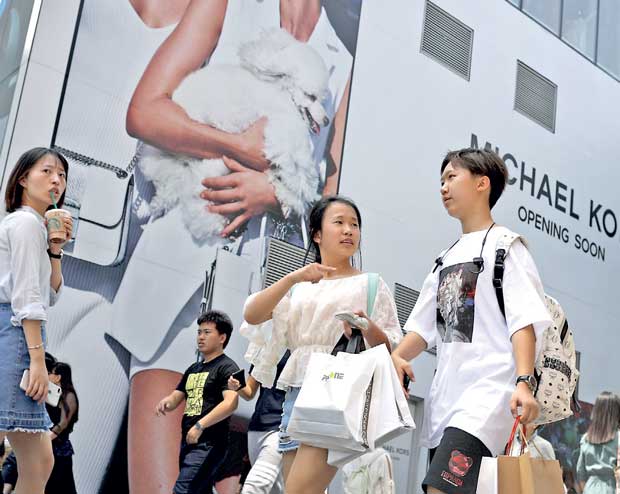Reply To:
Name - Reply Comment
Last Updated : 2024-05-18 04:00:00
 This new generation is expected to drive 65 percent of consumption growth of China until 2020, when they will make up around 53 percent of total consumption spending, up from 45 percent in 2016
This new generation is expected to drive 65 percent of consumption growth of China until 2020, when they will make up around 53 percent of total consumption spending, up from 45 percent in 2016
 In the 1950s and 1960s, the world economy was transformed by the emergence of the American consumer. Today, China’s rising ‘i-can’ generation is in the economic driving seat.
In the 1950s and 1960s, the world economy was transformed by the emergence of the American consumer. Today, China’s rising ‘i-can’ generation is in the economic driving seat.
China’s rapid social and economic transformation over the past three decades has given rise to a new age of consumer that we are calling the ‘i-can’ generation. Emboldened by years of economic growth, the ‘i-can’ generation is now empowered by the rising digital economy in China, represented by a new Taobao-WeChat digital purchasing and communication axis.
Essentially, China’s ‘i-cans’ leapt from the pre-web era straight to the mobile Internet, skipping the personal computer altogether. On the way, the ‘i-can’ generation’s e-commerce activity has created one of the world’s largest digital economies and is spawning a new generation of Chinese IT companies, which are now making their presence felt on the
global stage.
The ‘i-can’ generation demographics characteristics are very unique. They combine the features of the west’s baby boomers and millennials in one generation. What this means is, they have all the opportunity, optimism and wealth the baby boomers had with all the modern technology at their fingertips.
They are more globally minded than their parents. As products of the one-child policy, they have acquired an “I can do anything” attitude, which is now transforming the country’s society and economy. This new generation is also worldlier, entrepreneurial, individualistic, open-minded and is willing to spend.
The ‘i-can’ cohort represents more than 400 million people, accounting for almost a third of China’s population and amounting to more than the working population of the US and Western Europe combined. This new generation is expected to drive 65 percent of consumption growth of China until 2020, when they will make up around 53 percent of total consumption spending, up from 45 percent in 2016.
Their combined economic power is represented by a few statistics. The number of Internet users in China is more than 730 million, as big as the total population of the EU, or twice the population of the United States; more than 95 percent of these digital ‘i-cans’ are connected via their smartphones. Roughly half a billion use their smartphones to make payments. More than 200 million use them to order food takeaways. In one day last year, Singles’ Day, the ‘i-cans’ purchased US $ 17.8 billion – more than the United States’ Thanksgiving, Black Friday and Cyber Monday combined in the previous year.
There is no doubt that this generation is poised to become the dominant force in China’s consumer market, which will power the country’s economy growth. The ‘i-can’ generation’s spending power is resetting the country’s growth model based on domestic consumption over the traditional foreign-investment, export-led growth. This means, China’s ‘i-cans’ will soon become a force driving global economic growth. The‘i-can’ generation tends to be sophisticated and internationally-minded consumers. They are more selective about where they spend their money, shifting from products to services and from mass to premium segments. They are seeking a more balanced life where health and tailored experiences take priority. This means that they are likely to spend a greater proportion of their incomes on healthcare, lifestyle, entertainment, household goods and services rather than
daily necessities.
This change in consumption patterns has encouraged innovation and growth in the private sector to meet the rising consumer demand. This is particularly evident within the information technology industry, which has seen Chinese companies such as Alibaba in e-commerce, Tencent in social media and search giant Baidu, all become leading global businesses.
Some notable highlights include: in 2016, Chinese people spent US $ 5.5 trillion through mobile payment platforms – about 50 times the amount in the US. Users of Tencent’s WeChat sent around 46 billion digital red envelopes over the Chinese New Year period in 2017, while PayPal completed 6.1 billion payment transactions in the whole of 2016. Alibaba’s payments affiliate, Ant Financial’s Yu’e Bao became one of the largest online funds managing US $ 165 billion for more than 325 million clients, comprising 99.72 percent individual investors and 0.28 percent institutional investors by the end of 2016.
Moreover, China’s biggest P2P player, Ping An Insurance-backed Lufax had more than 28.38 million registered users at the end of 2016, an increase of 55 percent compared with the end of 2015. Lufax’s transaction volume reached roughly US $ 854 billion last year, up 280 percent from a year earlier.
And those players are not just providing a single mobile platform, they are integrating everything into a mobile-centric finance solution. Alibaba and Tencent are integrating different parts of life including payments for utilities, transport and hotels all together into their mobile platform. You can do almost anything, anywhere just by simply swiping your smartphone.
Put simply, customers can run a tally of their daily expenses through an accounting function on Alipay or Tenpay, which automatically records every transaction and analyses the flow of money.
Consumers also have access to lending, bartering and wealth management solutions such as trading of funds and stocks.
In the long term, this new, modern Chinese consumer ‘i-can’ generation will transform China into a more digital and consumer-driven economy.
And their massive spending power would be the primary engine, not just the backbone of China’s sustainable growth, but of global economic stability.
(Helen Wong is Chief Executive, Greater China, The Hongkong and Shanghai Banking Corporation Limited)

Add comment
Comments will be edited (grammar, spelling and slang) and authorized at the discretion of Daily Mirror online. The website also has the right not to publish selected comments.
Reply To:
Name - Reply Comment
The state-run loss-making State Mortgage & Investment Bank (SMIB) has reveale
US authorities are currently reviewing the manifest of every cargo aboard MV
On March 26, a couple arriving from Thailand was arrested with 88 live animal
According to villagers from Naula-Moragolla out of 105 families 80 can afford